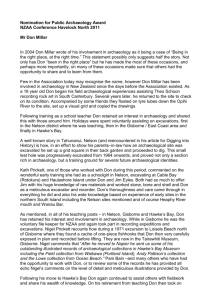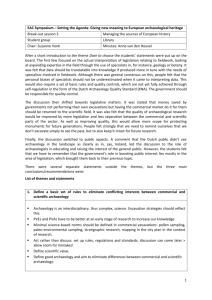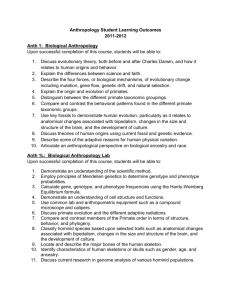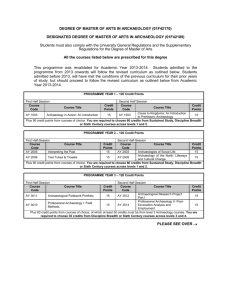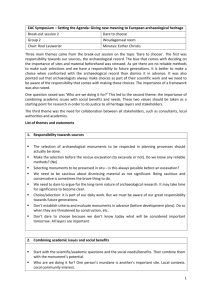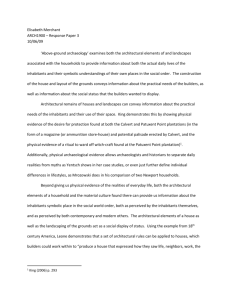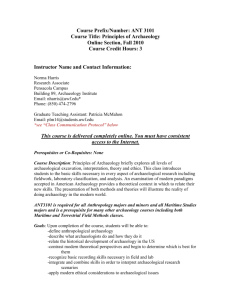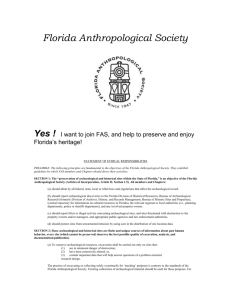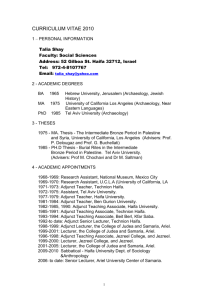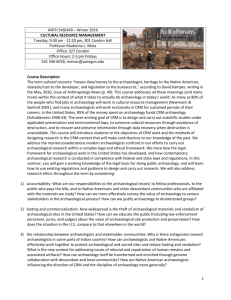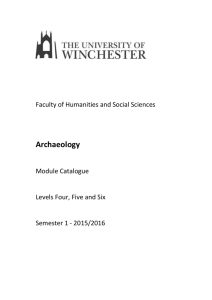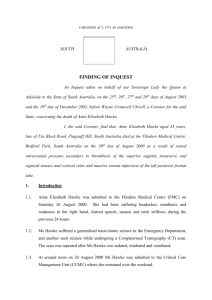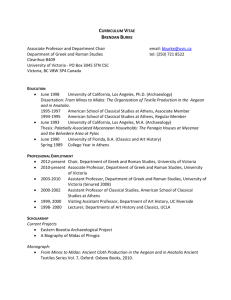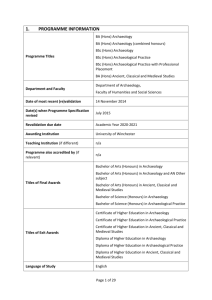An_Ethnologist
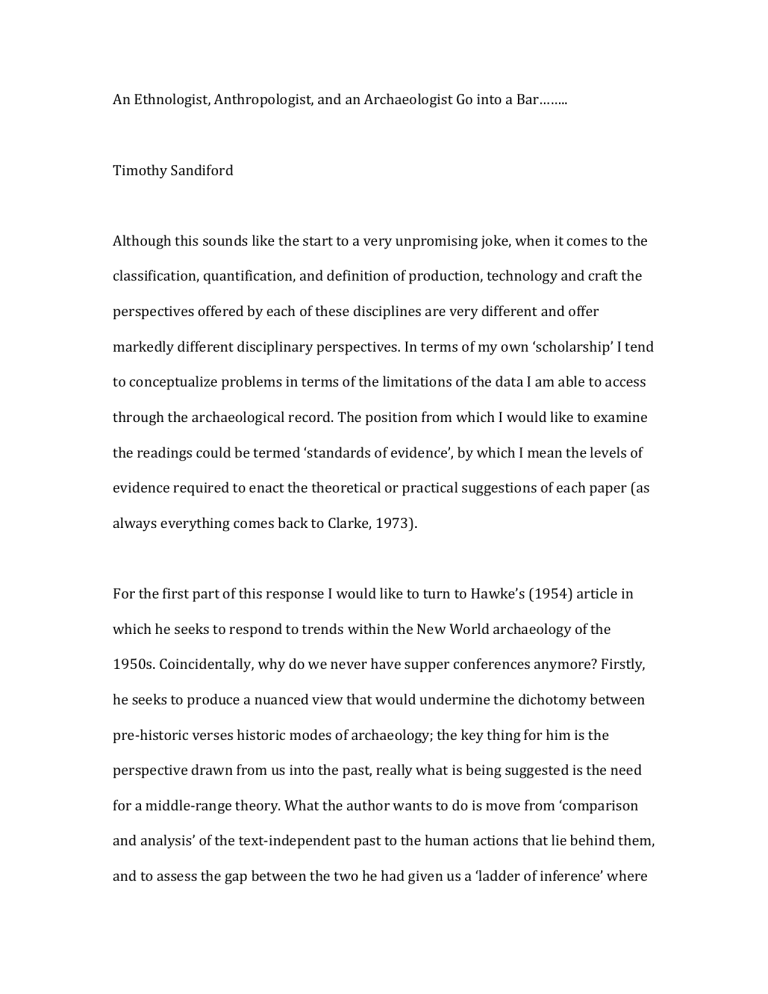
An Ethnologist, Anthropologist, and an Archaeologist Go into a Bar……..
Timothy Sandiford
Although this sounds like the start to a very unpromising joke, when it comes to the classification, quantification, and definition of production, technology and craft the perspectives offered by each of these disciplines are very different and offer markedly different disciplinary perspectives. In terms of my own ‘scholarship’ I tend to conceptualize problems in terms of the limitations of the data I am able to access through the archaeological record. The position from which I would like to examine the readings could be termed ‘standards of evidence’, by which I mean the levels of evidence required to enact the theoretical or practical suggestions of each paper (as always everything comes back to Clarke, 1973).
For the first part of this response I would like to turn to Hawke’s (1954) article in which he seeks to respond to trends within the New World archaeology of the
1950s. Coincidentally, why do we never have supper conferences anymore? Firstly, he seeks to produce a nuanced view that would undermine the dichotomy between pre-historic verses historic modes of archaeology; the key thing for him is the perspective drawn from us into the past, really what is being suggested is the need for a middle-range theory. What the author wants to do is move from ‘comparison and analysis’ of the text-independent past to the human actions that lie behind them, and to assess the gap between the two he had given us a ‘ladder of inference’ where
at one end we have techniques by which things are produced (easiest), and on the other we have religious institutions and spiritual life (hardest). Within this paradigm empirical data is the bedrock from which we can then edge out into theorizing human action. I think rather than a ladder Hawke’s ideas are best conceptualized as shooting target, with the rings on the outside (religious institutions/spiritual life) having the largest gap between ‘data’ (the center) and ‘theoretical’ reconstruction of the past. After Hawke’s has laid out the principle of the ladder the majority of the remainder of the article is concerned with establishing a solid chronology in which to situate the archaeological material; an understandable concern in a pre-absolute calibrated dating world. The key point of this article is that different types of evidence can support different levels of conclusion, although I do find Hawke’s treatment of how to go about assessing the evidence rather glib (and structuralist) and his concept of diffusion-spheres (which goes hand-in-hand with V. Gordon
Childe) has largely been proven as incorrect. Nevertheless, the concept that the nature evidence limits archaeology is key, and that different types of evidence require larger or smaller inferential jumps is vital. In terms of technology, however,
Hawke's view is too narrow, he conceives of technology as ‘how things are made’, but he fails to conceive that technology and production also touch on all the other fields of enquiry he suggests, really he takes a completely contrasting view to that of
Pfafferberger, which is to be expected given the dates of publication.
However, with this in mind I would like to turn to Lemonnier (1992). In the article he presents a very systematic, defined view of the anthropological theory of
technology where the evidentiary base is mainly situated in the ethnological analysis of contemporary and near-contemporary societies. For Lemonnier t
‘process’ is the key definition of technology “Technology embraces all aspects of the process of action upon matter” (1992:1) The ‘action’ upon matter by a human can be thought of as a ‘technique’ which can be in turn quantified into 5 categories. The article then continues to examine the effects of technology upon society before examining how data on the techniques can be objectively recorded, in an ethnographic framework, in a way that makes the results comparable. However, it is within the chapter on the Arbitrariness in Technologies that I feel that the failures of
Lemonnier’s analysis are most clear. In this part of the article the author draws the distinction between primary ‘functional’ and secondary ‘stylistic’ choices. Although I do have some problems with the characterization of traits within especially the
Anga (Papua New Guinea) my principle concern is how this method of analysis can be applied to archaeology. The level of data used in both this example and the example of plane design would be unattainable to virtually all periods of archaeological study. What is never addressed in any of these articles (with maybe the exception of Hawke's) is how do we theorize technology and production in the absence of direct observation and interaction with the producing society? The method most used within these articles is anthropological ethnography, which is fine when confined to examination of modern populations, but when this technique is applied to (especially) pre-historic societies it brings with it a whole new host of theoretical problems, not least of these being the concept of primitivism.
The concept of standards of evidence also remains unacknowledged within
Pfafferberger (1992), although this said I found this article to offer the most complete system through which to view technology. Pfafferberger sets-up in this article a sort of very large straw man in the form of the italicized passage on page
494, the author then proceeds to spend the remained of the article beating the living daylights out of it. Although this rhetorical device is somewhat false because
Pfafferberger is able to set the terms (by creating it) of his engagement with what he sees as the prevailing view of anthropological studies of technology, it is somewhat redeemed by the fact that the author is then able to suggest something in place of what he destroyed, namely the concept of the socio-technical system. This term refers to the linking of techniques, with material culture, and the social coordination of labor, Pfafferberger the states that these combine to form a seamless web, which creates a system capable of resisting dissociation. Again the problem I have with
Pfafferberger’s concept is how to bring them across from a purely anthropological perspective and into an archaeological framework. The standards and types of evidence needed to recreate the socio-technical system are so great that I feel it is beyond anything that we could hope to gain in pre-historic archaeology, and indeed probably for most periods in historical archaeology. In terms of an anthropological explanation of the theory of technology I find Pfafferberger’s ideas very interesting and for me they present the most complete picture of how to situate technology and production within anthropogenic action. However, as with all the other articles examined within this week’s reading, it is a systematic approach which does sit not too comfortably with a post-processual framework of archaeological theory.
